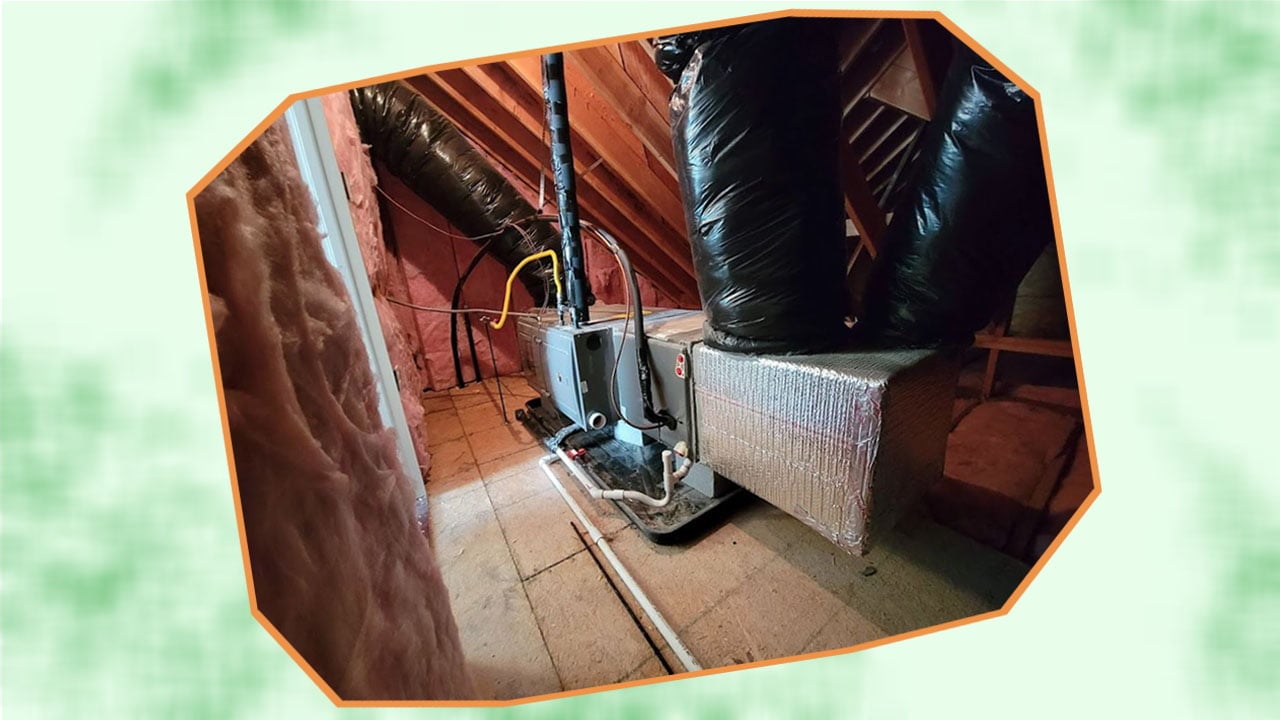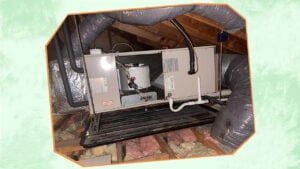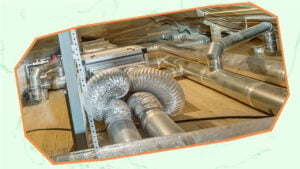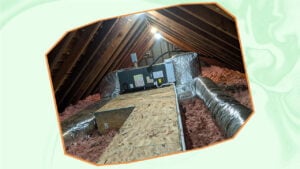Attic HVAC units are an efficient and energy-saving solution to regulating temperature in a house. That said, there are a few points to be mindful of before purchasing an HVAC system for optimum performance.

Summers can be particularly hot indoors, and the attic is usually where you can feel the heat at its worst.
Maintaining proper temperature in the attic is quite challenging because of how hot it can be, necessitating specific AC types to reach the desired temperature. Knowing all about these types of ACs is a crucial first step to implementing proper attic temperature regulation.
So, here’s a complete guide on attic HVAC units, their types, and what qualities they must possess. Worry about attic cooling no longer!
Types Of HVAC Units Suitable For Attics

HVAC systems, short for Heating, Ventilation, and Air Conditioning, are an all-encompassing solution used to address temperature regulation problems in a home. The term ‘HVAC’ is often used interchangeably with AC, although the latter is a subset of the former term.
When it comes to attic air conditioners, there is no single correct answer, as each type of HVAC unit comes with its own pros and cons. Luckily, choosing between them is made easier with what quality you’re prioritizing: cooling, budget, long or short-term usage, or energy conservation.
Let’s look at each type of attic HVAC system that you can consider installing.
1. Mini-Split Air Conditioners
Mini-split ACs are one of the best cooling HVAC unit types that you can install in your attic, being reliable and promoting an efficient energy use. One of the biggest advantages of this AC type is that it requires very little handling and no additional ductwork.
These HVAC units make for some of the most reliable ACs on the market, particularly for attics. They can easily last upwards of 15 years, which is significantly more than other attic cooling devices. Additionally, they can heat up the attic during the winter as well, making them devices that can be used all year long.
Mini-split air conditioners are typically installed far up on the wall, where they take up no physical floor space. Their compressor is installed outside and typically far away, making it so that the noise they make is barely noticeable at most.
There is one caveat associated with mini-split ACs, which is their price tags. Even the cheapest of these devices can set you back several hundred dollars more than other cooling devices. And once you get into the premium range, the price reaches well into the thousands. Add in installation charges, and your wallet may feel quite light after everything is said and done.
All things considered, a mini-split air conditioner gets you your money’s worth with all the features that they bring to the table.
2. Portable Air Conditioners
The main draw of a portable AC is its maneuverability, something that most other AC types cannot match. This is a type of HVAC unit that can effectively cool the attic, provided that they have access to proper ventilation through one or two hoses.
Portable ACs are quite light on the wallet, being one of the more affordable options. The energy efficiency that dual-hose models offer is middle-of-the-road, but this is balanced by their high cooling capacity.
There are a couple of caveats to installing portable air conditioners, namely the floor space they occupy and the venting hoses. While a portable air conditioner can be moved around freely, they do take up space in your attic that could be used for other purposes. You may feel this issue if your attic is not particularly large.
As for the venting hoses, they have to be threaded through a window or through a hole in the wall to expel hot air. If the AC has to be positioned far from the window, attaching the hoses can be a difficult affair. Of course, this becomes a non-issue if the portable air conditioner can be placed within a manageable distance from the window.
3. Window Air Conditioners
A window air conditioner can be an excellent option for cooling an attic- if your attic has one, that is. Window air conditioners make for some of the most affordable HVAC units available on the market and are capable of effective cooling in all attic sizes.
The energy efficiency of a window air conditioner is fairly high, and these will save you money on the electricity bill. This is particularly the case when compared to other AC types like the through-the-wall ACs. The efficiency of a window AC unit is only outmatched by the mini-split AC.
Of course, the biggest point of contention when it comes to using window ACs as your primary cooling device is the size of your window. Your attic window ought to be large enough to accommodate the AC- 15 inches or more in both length and width.
Moreover, if the window is an inclined roof window, mini-split AC and portable ACs are simply better options. The reason for this is plain and simple: it becomes exceedingly difficult or flat-out impossible to install a window AC on an inclined window.
But if your attic manages to tick everything on the requirements list, a window air conditioner may very well be the attic HVAC unit to choose.
4. Through-The-Wall Air Conditioners
As the name suggests, through-the-wall ACs are installed in a large hole in the wall that is typically created with a drill. A similar option for attic AC units is the through-the-roof unit, which functions similarly but is fitted through the roof instead.
These AC units are capable of solving the ventilation problem that plagues attics and can cool a small or medium-sized attic space well enough. You can expect to purchase a through-the-wall HVAC system in the medium range, being notably less expensive than options like mini-split or portable ACs.
The most prominent hurdle when considering a through-the-wall AC unit as a primary attic cooling device is the installation. If done without the help of professionals, you could potentially be looking at extensive structural damage to the wall. Suffice it to say, this is a task best left to the pros.
And if you’re going for a particular look for your attic, a through-the-wall AC may not give the most flattering impression of the space. These are big and bulky and cover a significant portion of the wall.
If function is all you’re looking for from your attic HVAC unit, a through-the-wall AC will serve the purpose just fine.
What To Look For In Attic ACs
Choosing an attic air conditioner is slightly different from doing so for your bedroom or office, owing to the temperature fluctuations in the crawlspace. There is no extra space left on the walls due to the slanted roofs, which is why not every AC type is suited for most attics.
Let’s look at what you should look for in an attic HVAC unit before purchasing.
1. BTU AC Units
BTU AC Units are a metric that is typically used to size an air conditioner for any given space. To put it simply, the higher the BTU rating of an AC, the larger the space it can cool.
A general rule of thumb given by the DOE for a room with an 8 feet tall ceiling is that every square foot of the living space requires 20 BTU. Meaning, a 500 sq. ft. room requires that your attic air conditioner have a rating of 10,000 BTU or higher to cool properly.
But this general rule doesn’t work with attics because of the slanted roofs, sun exposure, and building insulation. Once these are accounted for, you’ll find that the attic may require an air conditioner with a BTU rating slightly higher than what the rule would determine.
2. Energy Efficiency
Electricity bills add to the costs of an AC, and energy efficiency can help soften the blow of a high electricity bill significantly. Be sure to check the EER and SEER ratings of the attic AC before purchasing it.
Tip
The golden number to look out for when considering the energy efficiency of a device is 12 EER. An HVAC unit with a rating of 10 EER is also energy efficient, albeit to a lesser extent.
3. Ease Of Installation
The complexity of the installation can be a deal-breaker when choosing an HVAC unit for your attic. Naturally, an air conditioner that is easy to install and fits your space well is the ideal one.
Some air conditioner types can be quite difficult to install, and this is reflected in the installation charges. You may find that some companies may charge a few hundred dollars for installing a single AC unit, which is quite a hefty price.
In general, if installing the attic air conditioner is simple enough, you may want to do it yourself. Certain air conditioner brands offer DIY installation kits for their cooling devices, particularly with mini-split ACs.
4. Lifespan
The longer an HVAC unit lasts, the better an investment they make. Replacing HVAC units can be quite costly, after all.
Mini-split ACs have some of the longest lifespans in the attic HVAC range, lasting up to 20 years with proper maintenance. These units may be the way to go if you have a permanent place to live in and won’t move around frequently.
On the flip side, if you’re looking for a short-term solution, portable ACs will work fine as well with a lifespan of 5-10 years.

Attic HVAC Units: The Benefits
1. Low Power Consumption
Since the sun heats up the roof, the air inside the attic space becomes increasingly more difficult to cool. Thus, room air conditioners consume extra power to cool a house, particularly in a warm climate. This can impact your energy bills by a significant amount, something that is far from ideal.
Installing an air conditioner in the attic prevents hot air from escaping into your house, consequently making it easier to cool other rooms. Easier cooling in other rooms means less power consumed overall, which will help lower the electricity cost as well.
Consider using attic ventilation fans to further reduce the load on your air conditioner.
2. Protect Roof Shingles
The part of your home that faces the most heat from the sun is your roof. As such, the excessive heat that your roof shingles have to endure weakens them over time, which can result in a reduced lifespan.
Tip
You can prevent cracked or broken shingles by cooling your attic with an air conditioner and reducing the overall heat of the roof.
3. Structural Damage To The Walls
As a result of the roof heating up, the air inside your attic will also warm up, causing them to become superheated. Not only does this raise your power consumption, but the wooden framing of your attic also suffers as a result. This can compromise the structural integrity of the walls in your attic as well.
Further exacerbating the issue, the structural damage can end up warping other walls and door frames in your home. This can have long-lasting consequences, something that can be completely avoided by installing an attic air conditioner.
4. Reduced Noise
Room air conditioners are quite loud by design, and that hasn’t changed much since their inception. Continued exposure to the noises produced by these devices can damage your hearing capabilities, depending on where the unit is placed. Being close to them for extended periods of time is, at the very least, an unpleasant endeavor.
By stowing away the indoor unit or furnace in the attic, you’ll find that the amount of noise you hear from the units downstairs is reduced drastically. This is particularly important as, if placed elsewhere, air conditioners can be quite loud and make it difficult to sleep during the night.
5. Short Ducts
Some HVAC systems require ducts to transfer air throughout the house, and their placement predicates how much ductwork you will need to perform. Placing these in the basement, for example, will require the most extensive ductwork compared to any other location.
Some attic air conditioners require shorter ducts by design, making them beneficial in terms of both cost and maintenance. Low installation costs are a benefit, to begin with, and reduced hassle while maintaining ends up paying dividends in the long run utility wise.
Additionally, a shorter duct system will make your attic air conditioner more power efficient. The chance of a rupture leaking out a lot of air is drastically reduced with low ductwork, after all.
Attic HVAC Units: The Issues
1. Low Accessibility
Attic HVAC units require annual inspection and maintenance, something which can be performed by a trained technician. If your attic is small, it can be a bit difficult to access the ductwork of your air conditioner for maintenance and cleaning purposes. Small and cramped attics make it difficult for even seasoned professionals to perform a thorough inspection.
Moreover, replacing air filters every month can become excessively difficult in small attics, which can become even more of a problem in the long run.
2. Attic Air Leaks
Air leaking through the ducts is always a possibility, which hampers the efficiency of your HVAC system. This is a problem that affects not only the system efficiency but the environment in the attic as well. Leaking air can create an uncomfortably humid environment in the attic through condensation.
If the issue of humidity isn’t addressed quickly, the attic can face rot or mold as well. Exposed wood beams and walls don’t fare well against moisture, and excessive moisture can lead to structural weakness.
3. Efficiency Issues With Exposed Ducts
Attic air conditioner units often leave ducts bare, which is convenient for maintenance but can become an issue for system efficiency. Exposed ducts leave the air inside them susceptible to being affected by the attic temperature, which makes temperature regulation more challenging for the system. The HVAC system has to work harder to maintain temperature and to do so, it requires more power.
Insulated ducts are the way to go to deal with this issue, mitigating the amount of energy lost in the process.

Conclusion
The attic makes for one of the best places to install your HVAC unit in your house. Doing so keeps the system and the extensive ductwork out of the way, and you will save money in the process as well.
Accompanying the host of benefits of an attic AC unit are a few issues that need to be dealt with in an orderly fashion. Leaving these issues unaddressed can, in the mildest cases, cause your indoor unit not to work as efficiently as possible. In worse cases, it can lead to structural damage.
At the end of the day, installing an HVAC unit in your attic is a decision that isn’t completely straightforward. Some attics lack room or have certain quirks that make AC installation more difficult. Before you leap into purchasing one for your attic, consider consulting a technician for personalized information on the matter.
